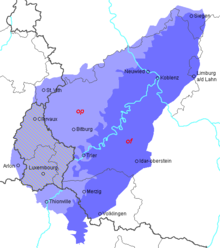Language history of the city of Dillingen / Saar
The language history of the city of Dillingen / Saar has a very old origin.
Language history and dialect
origin
At the end of the Roman Empire , today's Dillingen urban area with the province of Belgica I , i.e. the entire area around the Moselle and Saar , belonged to the Romance-speaking area . The predominant language in Contiomagus (today Pachten ) and the entire area was Moselle Romanic . The language area was inhabited by Celtic tribes . At the same time, many Laeten ( Germanic mercenaries in Roman service) had settled here. After the fall of the Roman Empire, the Franks migrated to the area. The Franks, who lived in Holland , Brabant and Flanders , moved the Ourthe and Sauer downwards in the south-east and up the Upper Moselle to around Metz . In doing so, they split the old Gallo-Roman area between Trier and Arlon over a width of about 60 kilometers.
The adoption of the Celtic river names Saar and Prims indicates population continuity. However , the old Roman name Contiomagus was lost in leases when Franconian settlers moved their graves into the ancient vicus. Perhaps the name Pachten (dialect in Paaten) refers to the old Roman roads between Metz and Mainz , Trier and Strasbourg , which still existed as “paths” and crossed here.
While the Franks were assimilated by the Gallo-Romans west of the Moselle , Franconian language remained predominant in today's Dillingen urban area and its wider surroundings. The Frankish repopulation was probably a movement that was at least partially directed by royalty. The leader of the respective founding group immortalized himself in the entire settlement area through the place names: In Dillingen, presumably a leader named "Dullo", who added the suffix '-ingen' to his name. The locative dative plural -ingen ( old Franconian -ingan ) initially served as a job name that was transferred to the actual place name.
Moselle-Franconian dialect
Today the Dillinger dialect belongs to the Moselle-Franconian dialects and is therefore a West Central German dialect . It belongs to the Middle Franconian dialects . Dillingen lies with the Saarlouis district immediately north of the dat-das-line . With regard to the High German sound shift , 'wat' and 'dat' remain unchanged in Dillingen. Also remain unshifted: 'it' / 'et', 'dit', 'allet' and the adjective ending of the neuter (e.g. “schenet ”for“ beautiful ”). "P" in the initial and "PP" in the initial are not shifted: So one says "Pund" instead of "pound" and "Appel" instead of "apple". On the other hand, the “t” is shifted: as with “Wasser”, “Zeit”, “Katz”. Within the Moselle Franconian dialect, the Dillinger dialect can be assigned to the 'of' area. The internal German consonant weakening and the High German diphthongization are complete.
The manifestation of the border lines (e.g. the course of the das-dat line from Völklingen to the north-east) can be explained by denominational and political circumstances: Before 1815, the Rhine-Franconian language areas of the Saarland essentially belonged to the Protestant rulers (e.g. the County of Saarbrücken and the Duchy of Zweibrücken ), while Dillingen, along with all other Moselle-Franconian-speaking places in Saarland, belonged to the sphere of influence of the Catholic Electorate of Trier. Due to the historical influence of France on Dillingen, numerous Gallicisms have also been adopted in the Dillinger dialect.
Due to the mobility of the population, the dividing line between the Moselle Franconian and the Rhine Franconian can no longer be drawn so sharply. Words and idioms begin to align, overlap and combine. An example would be the replacement of the old Dillinger “braat” (brought) with “gebrung” or the replacement of “eisch / meisch / deisch” with “isch / misch / disch”.
See also
literature
- Erich Labouvie: Studies on the syntax of the dialect of Dillingen on the Saar. Elwert'sche Verlagsbuchhandlung, Marburg 1938.
- Aloys Lehnert: History of the city of Dillingen Saar. Krüger printing works, Dillingen 1968.
Individual evidence
- ↑ Wolfgang Jungandreas: On the history of the Moselle Romanic . Wiesbaden 1979.
- ↑ Rudolf Post: On the history and research of the Moselle Romansh . In: Rheinische Vierteljahrsblätter 2004, pp. 1–35.
- ^ Walter Kiefer: Leases - Dillingen - Diefflen, pictures of yesterday and today (1885-1985) . Selbstverlag, n.d., p. 8. Kiefer quotes the Dillingen pastor Philipp Schmitt in his work The District of Saarlouis and its Surroundings under the Romans and Celts , Trier 1850. Schmitt writes “Maybe is Pahd, already 817 Path for path, since the bad pf was never used with us, the trunk; so that leasing meant as much as a village on the road like Vicus "
- ↑ Wolfgang Behringer, Gabriele Clemens: History of the Saarland . Munich 2009, pp. 15-16.
- ↑ Erich Labouvie: Studies on the syntax of the dialect of Dillingen an der Saar, Marburg, Elwert'sche Verlagsbuchhandlung 1938.
- ↑ Lehnert, Aloys: "History of the City of Dillingen Saar", Krüger printing works, Dillingen 1968, pp. 234–235.
- ↑ Hermann Niebaum, Jürgen Macha: Introduction to the dialectology of German . 2., rework. Edition, Tübingen 2006, p. 222.
- ↑ Aloys Lehnert: The Saarland dialects . In: Klaus Altmeyer (Ed.): Das Saarland, A contribution to the development of the youngest federal state in politics, culture and economy . Saarbrücken 1958, pp. 409-439, p. 410.
- ↑ Brockhaus: The Encyclopedia in Twenty-Four Volumes , 20th, revised and updated edition, 5th volume: CRO-DUC, Leipzig, Mannheim 2001, p. 369.
- ↑ Hans Ramge: Dialektwandel im Mittel Saarland, publications by the Institute for Regional Studies in Saarland, Volume 30, Saarbrücken 1982.
- ↑ Lehnert, Aloys: "History of the City of Dillingen Saar", Krüger printing works, Dillingen 1968, p. 234.

